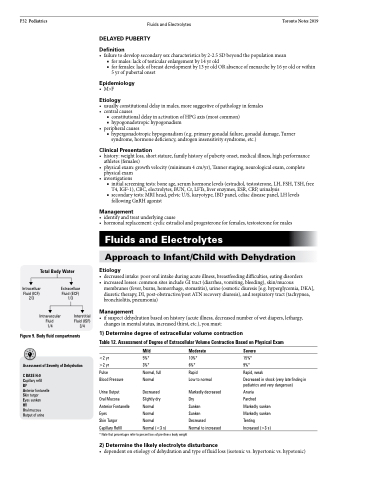Page 1066 - TNFlipTest
P. 1066
P32 Pediatrics
Fluids and Electrolytes Toronto Notes 2019 DELAYED PUBERTY
Definition
• failuretodevelopsecondarysexcharacteristicsby2-2.5SDbeyondthepopulationmean
■ for males: lack of testicular enlargement by 14 yr old
■ for females: lack of breast development by 13 yr old OR absence of menarche by 16 yr old or within
5 yr of pubertal onset
Epidemiology
• M>F
Etiology
• usuallyconstitutionaldelayinmales,moresuggestiveofpathologyinfemales • centralcauses
■ constitutional delay in activation of HPG axis (most common)
■ hypogonadotropic hypogonadism • peripheralcauses
■ hypergonadotropic hypogonadism (e.g. primary gonadal failure, gonadal damage, Turner syndrome, hormone deficiency, androgen insensitivity syndrome, etc.)
Clinical Presentation
• history:weightloss,shortstature,familyhistoryofpubertyonset,medicalillness,highperformance athletes (females)
• physicalexam:growthvelocity(minimum4cm/yr),Tannerstaging,neurologicalexam,complete physical exam
• investigations
■ initial screening tests: bone age, serum hormone levels (estradiol, testosterone, LH, FSH, TSH, free
T4, IGF-1), CBC, electrolytes, BUN, Cr, LFTs, liver enzymes, ESR, CRP, urinalysis
■ secondary tests: MRI head, pelvic U/S, karyotype, IBD panel, celiac disease panel, LH levels
following GnRH agonist
Management
• identifyandtreatunderlyingcause
• hormonalreplacement:cyclicestradiolandprogesteroneforfemales,testosteroneformales
Fluids and Electrolytes
Approach to Infant/Child with Dehydration
Etiology
• decreasedintake:poororalintakeduringacuteillness,breastfeedingdifficulties,eatingdisorders
• increasedlosses:commonsitesincludeGItract(diarrhea,vomiting,bleeding),skin/mucous
membranes (fever, burns, hemorrhage, stomatitis), urine (osmotic diuresis [e.g. hyperglycemia, DKA], diuretic therapy, DI, post-obstructive/post ATN recovery diuresis), and respiratory tract (tachypnea, bronchiolitis, pneumonia)
Management
• ifsuspectdehydrationbasedonhistory(acuteillness,decreasednumberofwetdiapers,lethargy, changes in mental status, increased thirst, etc.), you must:
1) Determine degree of extracellular volume contraction
Table 12. Assessment of Degree of Extracellular Volume Contraction Based on Physical Exam
Total Body Water
Intracelluar Fluid (ICF) 2/3
Intravascular Fluid
1/4
Extracelluar Fluid (ECF) 1/3
Interstitial Fluid (ISF) 3/4
Figure 9. Body fluid compartments
Assessment of Severity of Dehydration C BASE H20
Capillary refill
BP
Anterior fontanelle Skin turgor
Eyes sunken HR
Oral mucosa Output of urine
<2 yr >2 yr
Pulse
Blood Pressure
Urine Output
Oral Mucosa Anterior Fontanelle Eyes
Skin Turgor Capillary Refill
Mild
5%* 3%*
Normal, full Normal
Decreased Slightly dry Normal Normal Normal Normal (<3 s)
Moderate
10%* 6%*
Rapid
Low to normal
Markedly decreased Dry
Sunken
Sunken
Decreased
Normal to increased
Severe
15%* 9%*
Rapid, weak
Decreased in shock (very late finding in pediatrics and very dangerous)
Anuria
Parched Markedly sunken Markedly sunken Tenting Increased (>3 s)
* Note that percentages refer to percent loss of pre-illness body weight
2) Determine the likely electrolyte disturbance
• dependentonetiologyofdehydrationandtypeoffluidloss(isotonicvs.hypertonicvs.hypotonic)


